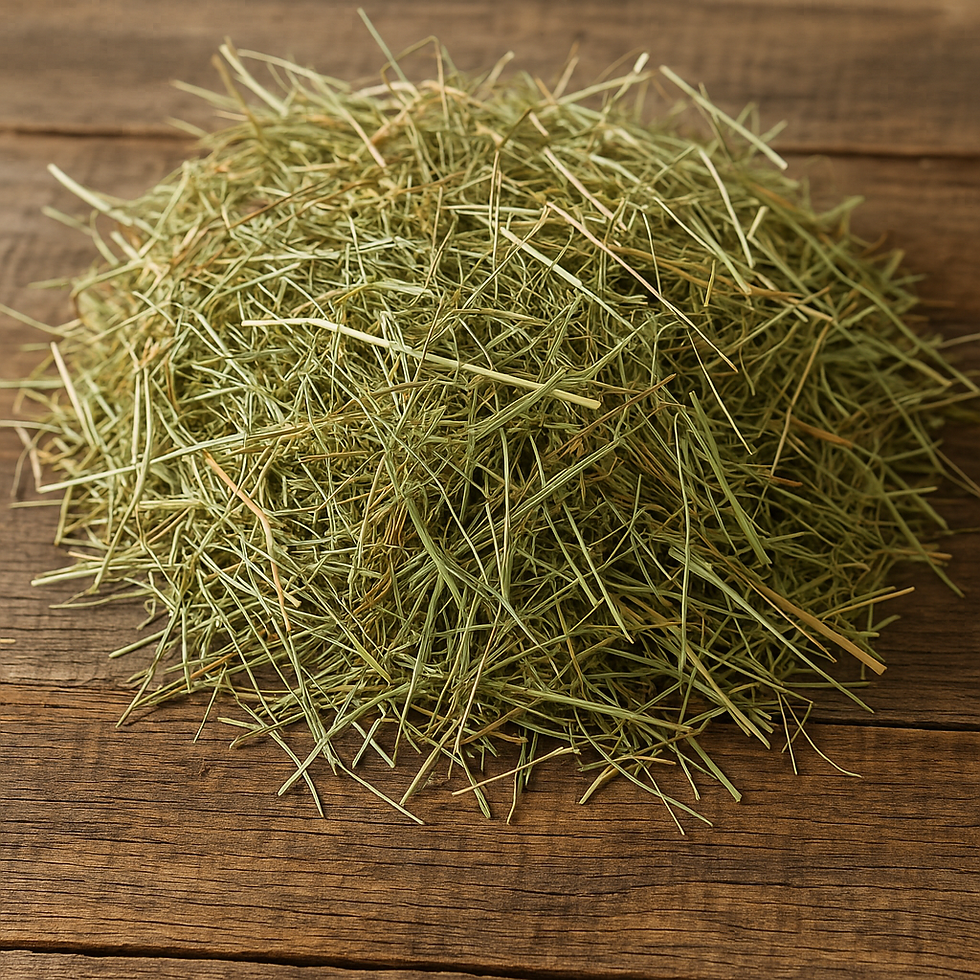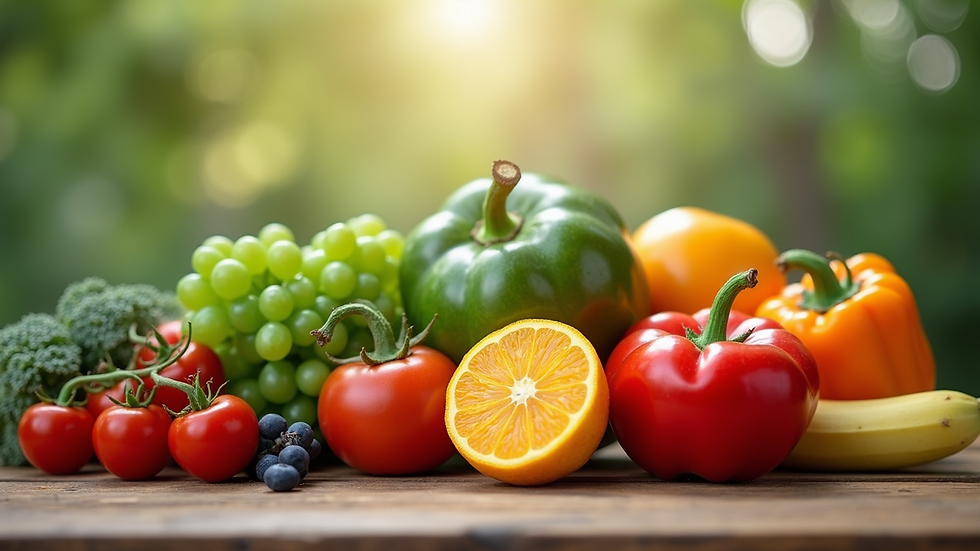Species-Appropriate Diet for Horses: Nourishing the Equine Body as Nature Intended
- Sep 19
- 6 min read

Why Diet Matters
Horses are extraordinary creatures — athletic, sensitive, and deeply attuned to their environment. They are also incredibly vulnerable to the choices we make in how we feed them. A horse’s diet is not simply about calories or body weight; it is about supporting their physiology, their digestion, their immune system, and even their behavior.
Modern feeding practices have drifted far from what nature intended. Bags of “complete feed” promise convenience, quick shine, or a performance edge, but they often undermine long-term wellness. By returning to a species-appropriate diet, we honor the horse’s design — building a foundation for balance, soundness, and whole-horse wellbeing.
The Horse’s Digestive Design
To understand what “species-appropriate” means, we must begin with biology. Horses are hindgut fermenters, designed to consume small amounts of forage almost continuously — grazing for 16–18 hours a day. Their stomach is small and empties quickly, while the cecum and colon serve as fermentation vats where beneficial microbes break down fibrous plants into energy.
This system thrives on steady, fibrous forage. When we feed against it — with large, starchy meals or long fasting periods — the results are predictable: ulcers, colic, laminitis, and behavioral issues. Supporting the horse’s natural grazing design is the foundation of any truly healthy diet.

The Flaws in Modern Feeding Practices
Grains & Starches
Oats, corn, barley, and molasses-based feeds deliver quick energy but create dangerous blood sugar spikes. Over time, these contribute to insulin resistance, laminitis, and metabolic disorders.
Soy
Soy products (often in the form of soybean meal or soybean hulls) are cheap protein sources, but they are also highly inflammatory and can disrupt the endocrine system. Horses with metabolic, immune, or skin issues often improve dramatically when soy is removed. They are often the source of a lot of allergies in horses.
Alfalfa
Alfalfa hay and pellets have their place, but they are often overfed. While high in calcium and protein, they can create imbalances and do not suit every horse, particularly those with metabolic sensitivities. And for horses with underlying kidney issues, alfalfa can be a nightmare on them.
Beet Pulp
Frequently marketed as a “super fiber,” beet pulp is actually a byproduct of sugar production. It is often treated with chemicals, stripped of natural nutrients, and difficult for some horses to digest.
Fillers & Byproducts
Perhaps the most overlooked issue in horse feed is the widespread use of fillers. These are ingredients added primarily for bulk, palatability, or to reduce production costs, with little to no nutritional value for the horse.
Common examples include:
Soybean hulls
Wheat middlings
Beet pulp
Rice bran
6. Balancers: The main point of feeding a balancer is to provide concentrated vitamins, minerals, and amino acids to “fill nutritional gaps” that forage alone is believed not to cover. They are often recommended for horses on low-calorie diets, such as so-called “easy keepers.”
While this sounds practical, the reality is that balancers are simply a synthetic solution to a man-made problem. Most gaps exist because horses are fed processed feeds and forages grown in depleted soils. By returning to whole-food nutrition with clean forage, herbs, and natural mineral sources, we address these gaps in a way the body actually recognizes and utilizes.
If horses are fed a true species-appropriate diet — forage, herbs, and whole foods — balancers are unnecessary. Real food provides naturally balanced nutrition, without the need for synthetic patches.
Because these ingredients lack true balance, feed companies must add back isolated synthetic vitamins and minerals in an attempt to make the feed “complete.” The result? Horses consume a highly processed, inconsistent diet that stresses their digestive system and offers less real nourishment than simple, high-quality forage.

The Forage-First Foundation
Nature designed horses to thrive on grass. In domestication, grass hay (timothy, orchard, meadow mixes) becomes the backbone of a healthy diet. Whenever possible, free-choice hay supports both physical and emotional wellbeing by reducing stress and maintaining gut function.
For horses without pasture access or those needing targeted nutrition, forage pellets or cubes make excellent carriers for whole-food supplements and herbs. This approach replaces “sweet feeds” with a clean, species-appropriate base.
Other essentials include:
Free-choice salt (plain, not mineral blocks loaded with binders or molasses).
Clean, pure water at all times.
Optional trace mineral sources depending on local forage deficiencies.
Forage-first isn’t trendy — it’s simply returning to what horses evolved to eat.
Whole Food Supplements: Filling the Gaps
Even the best hay often falls short in today’s world, where soil depletion and farming practices have reduced natural nutrient density. Rather than turning to synthetics, we can use whole foods to fill the gaps:
Camelina Meal: A rich source of omega fatty acids that support joints, skin, coat, and inflammation balance.
Kelp: Provides trace minerals directly from the sea in a bioavailable form.
Nutritional Yeast: Supplies natural B vitamins critical for nervous system health.
Diatomaceous Earth: A natural source of silica that supports connective tissue and gut integrity.
Bentonite Clay: Binds toxins and aids detoxification naturally.
Whole foods nourish on multiple levels — offering enzymes, cofactors, and synergy that synthetic isolates simply cannot replicate.
The Role of Herbs in Nutrition & Healing
Herbs are not “extras” — they are the original nutritional supplements. Long before commercial feeds existed, horses browsed hedgerows and pastures rich in medicinal plants.
Plants bridge the gap between food and medicine. In the practice of applied zoopharmacognosy, horses often self-select herbs that address underlying imbalances — a powerful reminder of their innate wisdom. And when we synergistically blend specific herbs properly we not only add vital nutrients but heal the body as well.
The Bigger Picture: Environment + Diet = Wellness

Diet is foundational, but it cannot exist in isolation. A horse living in a stressful environment, without movement or social interaction, will struggle to thrive even on the best forage.
True wellness comes from aligning all three pillars:
Forage-first, species-appropriate diet.
Freedom to move and interact with other horses.
Low-toxin, supportive environment.
When diet supports the body and environment supports the mind and spirit, healing becomes possible at the deepest level.
Practical Recommendations
Keep it simple. Horses don’t need complicated feed programs.
Transition gradually. Sudden diet changes disrupt the microbiome and increase colic risk.
Observe your horse. While species-appropriate feeding is universal, every horse is an individual. Notice how they respond to different hays, herbs, or supplements.
Avoid marketing hype. Remember that “complete feeds” are designed for profit and convenience, not for equine biology.
My Horses’ Base Diet: A Real-World Example
At Wholehearted Harmony, I don’t just write about species-appropriate feeding — I live it every day with my own horses. Their base diet is intentionally simple, built on the foundation of forage and whole foods:
Forage Pellets: Timothy or orchard pellets form the base, ensuring clean, consistent fiber.
Whole Food Additions: Camelina meal, kelp, nutritional yeast, and diatomaceous earth provide omegas, trace minerals, B vitamins, and silica. Fruits and vegetables are rotated and given in handful a long with their forage base. Beets, sweet potatoes, carrots, kale, blueberries, strawberries, bananas, pears and more, all in moderation of course.
Herbal Support: I rotate herbs or herb blends for each of my horses depending on seasonal changes, workload, and, in general, if I notice something seems off. These blends are created after I herb test my horses, allowing them to guide the process and choose what their bodies truly need.
Free-Choice Salt & Clean Water: Always available and essential for hydration and mineral balance.
Nothing fancy, nothing processed — just whole, natural ingredients that support the body the way nature intended. Over the years, I’ve seen the difference in shiny coats, strong hooves, calm minds, and resilient health.

Conclusion: Returning to the Horse’s Design
When we strip away the marketing and return to the basics, the truth is clear: horses are healthiest when fed as nature intended. A species-appropriate diet — forage-based, free of fillers, and supported with whole foods and herbs — builds the foundation for vitality, soundness, and resilience.
By choosing forage over fillers, whole foods over synthetics, and herbs over chemicals, we empower horses to thrive. In doing so, we not only prevent illness but also unlock the potential for deeper connection, performance, and whole-being wellness.
With Love, Herbs & Harmony
~Debbi, Wholehearted Harmony




Comments